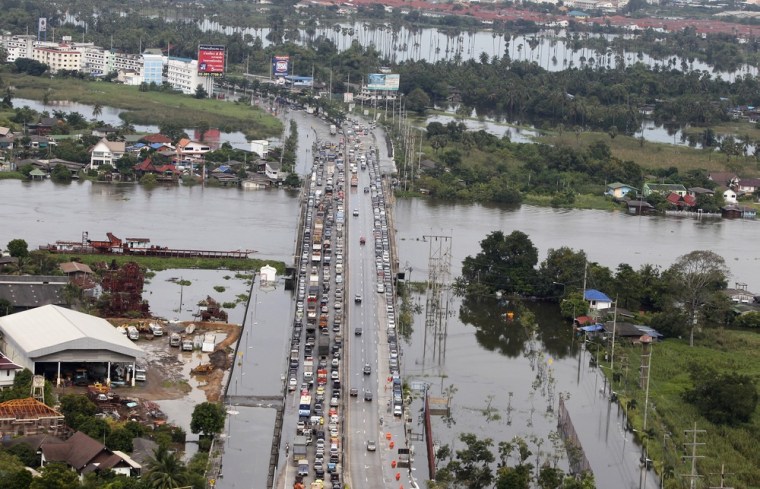Somjai Tapientong lives on one side of a wall of white sandbags, her apartment perched precariously on the front line of an epic battle to stop the deadliest floods in decades from reaching Bangkok.
On the other side, a foaming brown river gushes through a canal diverting water around the Thai capital, just to the south. Whether floodwaters breach the top of fortified barriers like these this weekend will determine whether Bangkok will be inundated or spared.
On Saturday, the giant metropolis of glass-walled condominiums and gilded Buddhist temples was anxiously bracing for an answer to that question. Despite the panic that has engulfed the city of 9 million people for days, though, many believe its defenses just might hold.
"I'm not afraid," said Somjai, a 60-year-old hair dresser in Rangsit, whose canal is crucial to protecting the capital. "A lot of people are paranoid, but I don't feel that panic."
Speaking Friday, Prime Minister Yingluck Shinawatra insisted that floodwaters flowing down from the central plains "will only affect outer Bangkok and will not be widespread in other areas."
Such assurances have not stopped Bangkokians from raiding supermarket shelves to stock up on bottled water, dried noodles, flashlight batteries and candles if things go bad. Worried car owners are cramming vehicles into high-rise parking spaces at city's malls and airports. International hotels and street-side shops have barricaded their entranceways with sandbags.
Television stations broadcasting images of swamped towns just north of the capital — showing waterlogged residents in canoes and braving chest-high water — have also inadvertantly fueled fears of imminent doom in the capital.
But Chusit Apirumanekul, a hydrologist at Asian Disaster Preparedness Center, said "that will not happen in ... the inner part of Bangkok."
There is always the possibility of flooding, he said, "but it will be very low."
Incessant monsoon rains have killed nearly 300 people in Thailand since July, part of a wave of extreme weather including back-to-back typhoons that has plagued Asia this year. In neighboring Cambodia, floods over roughly the same period have killed another 247 people.
Thailand's lucrative tourist destinations — beaches and islands like Koh Samui, Krabi and Phuket — have not been affected. But the floods have affected 8 million people and swept two-thirds of the country, drowning rice fields and swallowing low-lying villages along the way. More than 200 major highways and roads are impassable, and the main rail lines to the north has been shut down.
By contrast, the government says most of Bangkok, which lies about six feet (two meters) above sea level, sits safely behind an elaborate system of flood walls, canals, dikes and seven underground drainage tunnels which were completed over the last year.
The latest floods are posing the biggest test those defenses have ever faced. Water rushing down from the north toward the sea is expected to be bolstered by heavy rains due this weekend. Rising ocean tides are expected to slow a critical outflow of water from the Chao Phraya River, which winds through Bangkok and into the Gulf of Thailand.
Just beyond Bangkok's northwestern border, in the town of Samkhok, floodwaters breached a wall of white sandbags several dozen miles (kilometers) long, submerging temples and homes up to the top of their wooden gates.
"The problem is, the water keeps rising, and nobody knows how bad it's going to get," said Wasan Leekmeg, a local politician in Samkhok who spent the last few days ferrying supplies to desperate businesses and families on a wooden canoe — now the only way to get around some parts of the town.
On Friday, a Japanese trade organization criticized the Thai government for allegedly failing to provide timely and accurate information about the situation in the central province of Ayutthaya, where hundreds of factories have been devastated, including electronics makers and automotive parts suppliers.
"Japanese companies didn't know what was happening or which information was true or not," said Seiya Sukegawa of the Japan External Trade Organization Thailand. "They received warnings but not enough information and not enough time to decide the next step."
Chusit Apirumanekul, of the Asian Disaster Preparedness Center, sympathized with the huge challenge facing Thailand's government, saying the floods were unpredictable.
"I think this is quite normal in every country when you have this kind of warning, forecasting, you cannot say that it will happen or it will not happen 100 percent," he said.
